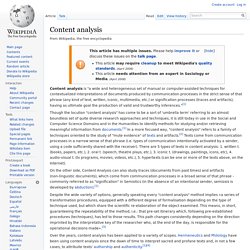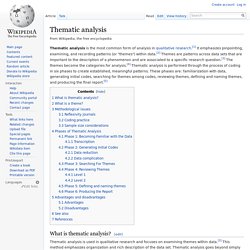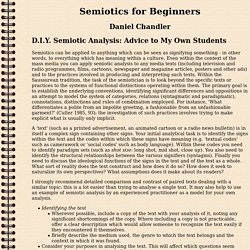

Content analysis. Content analysis is "a wide and heterogeneous set of manual or computer-assisted techniques for contextualized interpretations of documents produced by communication processes in the strict sense of that phrase (any kind of text, written, iconic, multimedia, etc.) or signification processes (traces and artifacts), having as ultimate goal the production of valid and trustworthy inferences.

"[1] On the other side, Content Analysis can also study traces (documents from past times) and artifacts (non-linguistic documents), which come from communication processes in a broad sense of that phrase - commonly referred to as "signification" in Semiotics (in the absence of an intentional sender, semiosis is developed by abduction).[1] Over the years, content analysis has been applied to a variety of scopes.
In recent times, particularly with the advent of mass communication, content analysis has known an increasing use to deeply analyse and understand media content and media logic. Thematic analysis. Thematic analysis is the most common form of analysis in qualitative research.[1] It emphasizes pinpointing, examining, and recording patterns (or "themes") within data.[2] Themes are patterns across data sets that are important to the description of a phenomenon and are associated to a specific research question.[3] The themes become the categories for analysis.[4] Thematic analysis is performed through the process of coding in six phases to create established, meaningful patterns.

These phases are: familiarization with data, generating initial codes, searching for themes among codes, reviewing themes, defining and naming themes, and producing the final report.[5] What is thematic analysis? [edit] There is a wide range as to what a "data set" entails (see qualitative data). Texts can range from a single-word response to an open-ended question or as complex as a body of thousands of pages.[8] As a consequence, data analysis strategies will likely vary according to size. Philosophical analysis. Philosophical analysis (from Greek: Φιλοσοφική ανάλυση) is a general term for techniques typically used by philosophers in the analytic tradition that involve "breaking down" (i.e. analyzing) philosophical issues.

Arguably the most prominent of these techniques is the analysis of concepts (known as conceptual analysis). This article will examine the major philosophical techniques associated with the notion of analysis, as well as examine the controversies surrounding it. Method of analysis[edit] Conceptual analysis consists primarily in breaking down or analyzing concepts into their constituent parts in order to gain knowledge or a better understanding of a particular philosophical issue in which the concept is involved (Beaney 2003).
For example, the problem of free will in philosophy involves various key concepts, including the concepts of freedom, moral responsibility, determinism, ability, etc. Controversy[edit] See also[edit] Notes[edit] References[edit] Bealer, George. (1998). Discourse analysis. Discourse analysis (DA), or discourse studies, is a general term for a number of approaches to analyze written, vocal, or sign language use, or any significant semiotic event.

5171_Berger_Final_Pages_Chapter_1.pdf. What is Semiotic analysis? Semiotics for Beginners: D.I.Y. Semiotic Analysis. Daniel Chandler D.I.Y.

Semiotic Analysis: Advice to My Own Students Semiotics can be applied to anything which can be seen as signifying something - in other words, to everything which has meaning within a culture. Even within the context of the mass media you can apply semiotic analysis to any media texts (including television and radio programmes, films, cartoons, newspaper and magazine articles, posters and other ads) and to the practices involved in producing and interpreting such texts.
Within the Saussurean tradition, the task of the semiotician is to look beyond the specific texts or practices to the systems of functional distinctions operating within them. A 'text' (such as a printed advertisement, an animated cartoon or a radio news bulletin) is in itself a complex sign containing other signs. I strongly recommend detailed comparison and contrast of paired texts dealing with a similar topic: this is a lot easier than trying to analyse a single text. Contents. Pitcher68.pdf.